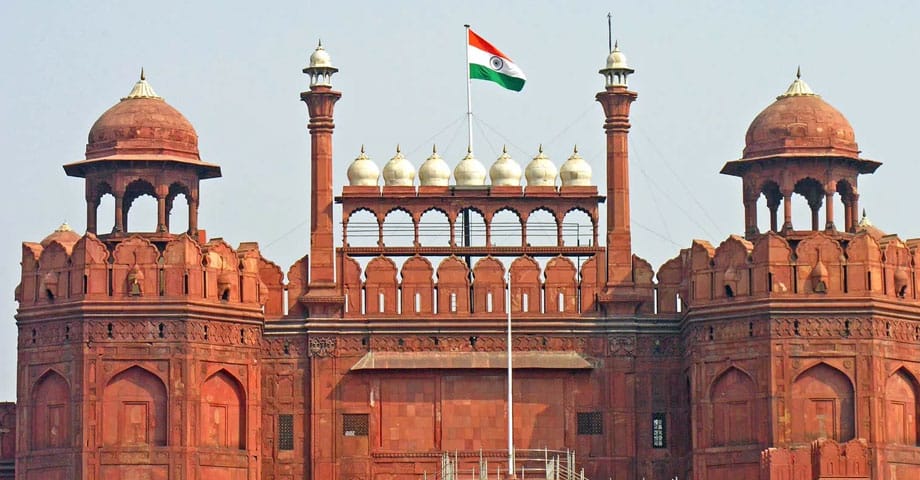- Have Any Question ?
- +91-9929358785
- 01414054824
- Info@thepinkcityholidays.com
Red Fort, Old Delhi

How to Choose the Best Rajasthan Tour Package
March 17, 2025
India Gate, Delhi
April 19, 2025One of the iconic monuments that symbolises the rich history of India is the famous Red Fort, also known as Lal Qila. Nestled in the centre of Old Delhi, this historical monument plays a vital role in celebrating Indian Independence.
This brilliantly built architectural monument not only tells the story of the historic past concerning the Mughal era but also proves to be an iconic landmark with a cultural heritage. It also symbolises the power and beauty of past facts.
History
Mughal Emperor Shah Jahan started the construction of this monument in the year 1639, ending in 1648. With the building complete, it became the new capital of the Mughal Empire, thus shifting the main residency from Agra to the Palace Fort of Shahjahanabad (old Delhi).
For nearly 200 years, it served as the main imperial residence until the rule of the British Raj began in the year 1857. This red sandstone monument has witnessed several historical events. From conducting the first ever Independence Day speech of India in 1947, done by Pandit Jawaharlal Nehru, to hoisting the national flag every year on 15th August. The Red Fort still holds national significance in the Indian state.
Facts about Red Fort
- Red Fort was declared a UNESCO World Heritage Site in the year 2007 for its unique ancient culture and historical significance in India.
- Every year on Independence Day, the Prime Minister of India hoist the national flag after giving a speech.
- Construction began in the year 1638 and ended in 1648, after which Mughal Emperor Shah Jahan moved its capital from Agra to Delhi.
- Witness a pearl mosque also known as Moti Masjid, which was an add-on done by Shah Jahan’s successor, Aurangzeb.
- When the fort was built, the limestone used was white, not red; when it came under the British Raj, they painted it red, naming it the Red Fort.
- This architectural marvel offers a glimpse into a historic monument with a complex of palaces, baths, halls, and gardens. All these beautiful corners are within the huge red sandstone monument wall.
- Red Fort consists of two main gates, one which is the main entrance-Lahori Gate, while the other is the gate used by royals, Delhi Gate.
- There are halls named as Diwan-i-Aam and Diwan-i-Khas which were used by Emperors to hold public and private audiences.
- Don’t miss out on the evening show Of light and sound that depicts the historical journey of the fort.
Timings
- Open Days: Tuesdays to Sundays
- Closed on: Mondays
- Visiting time: From 9:30 AM to 4:30 PM
- Sound and Light Show: Timings may differ depending on the season
- Hindi begins at 7:30 PM
- English begins at 9:00 PM
Entry Fees
You can book your tickets directly from the entrance or book from the online platform at the ASI website. The prices differ depending on nationality. Indians get to pay ₹35, whereas foreign tourists need to pay ₹500. Children under 15 years are free of entry charges.
How to reach?
Take the nearest metro station to Lal Qila from the Violet line; upon reaching, take a short walk to the destination.
Nearby Attractions
- Jama Masjid: A historical mosque nestled in New Delhi was designated by Mughal Emperor Shah Jahan.
- Chandni Chowk: One of the oldest and busiest markets in Old Delhi, India. Famous for selling spices, dried fruits, silver jewellery and saris.
- Raj Ghat: A memorial complex in Delhi, where the first memorial was dedicated to Mahatma Gandhi after his assassination in the year 1948.
- India Gate: Located near the Rajpath on the eastern edge of the ceremonial axis of New Delhi, this war memorial is dedicated to the troops of British India who died in the years between 1914 and 1919.
Location
Path:- Netaji Subhash Marg, Chandni Chowk, New Delhi- 110006
Why Visit the Red Fort?
Red Fort is known for having immersive stories of ancient India’s regal past that show its cultural pride and the architectural marvel that brings out the intellectual part of past times. The Mughal era culture and heritage can be seen on this arched gateway of the Red Fort with lush gardens, giving a peek into the historical past.
Take a trip to this iconic monument that symbolizes the regal past of India with the grand architecture of the Red Fort. One can immerse oneself in admiring the architectural beauty.





